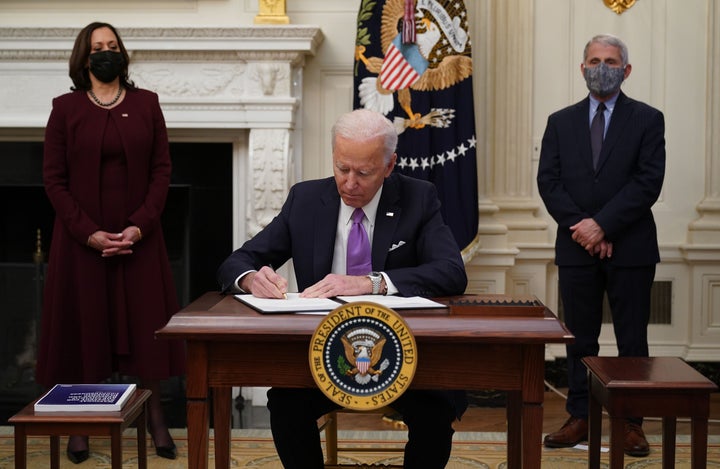On his first day in office, President Joe Biden moved to both erase the white supremacist legacy of the previous White House and address injustices that existed long before Donald Trump came to power.
“A cry for racial justice some 400 years in the making moves us. The dream of justice for all will be deferred no longer,” Biden said in his inaugural speech. Racial justice is one of the administration’s top priorities, alongside the pandemic and the economy, he said.
Later in the day, Biden issued an executive order on “Advancing Racial Equity and Support for Underserved Communities Through the Federal Government” to put his pledge into action. The order received scant attention amid a wave of actions from the White House, but it shouldn’t be overlooked. It has the potential to advance the cause of racial justice on several key fronts.
On Tuesday, Biden issued four more executive orders around racial justice: directing the Department of Housing and Urban Development to “redress racially discriminatory housing policies,” scaling back the federal government’s reliance on private prisons, condemning anti-Asian racism and underscoring the administration’s commitment to Native American tribal sovereignty, as Reuters reports.
“In the weeks ahead, I’ll be reaffirming the federal government’s commitment to diversity, equity and inclusion and accessibility, building on the work we started in the Obama-Biden administration,” Biden said Tuesday.
On top of the executive order, the White House’s push to raise the minimum wage would have outsize effects on African Americans, helping to narrow the black-white income gap.
And there’s symbolic change, too: a diverse administration that includes the country’s first Black and Indian American vice president. Biden’s Cabinet is the most racially diverse in history.
Even the currency may get an update: On Monday, the White House announced it’s taking steps to put Harriet Tubman on the $20 bill ― an Obama-era initiative killed by Trump.
What Biden’s doing feels like the delayed policy response to the protests that swept the country last summer after the police killing of George Floyd. At the time, millions of Americans were demanding racial justice, but the federal government was run by a man determined to maintain the status quo.
Erasing Trump’s Most Egregious Actions
The executive order on racial justice erased two of the Trump administration’s most blatantly racist policies. Biden reversed Trump’s move last fall to ban all federal agencies and contractors from conducting any kind of diversity training or programs that dealt with concepts like systemic racism or white privilege. Broad in scope and confusing, the order was widely criticised in the fall. The bottom line was that it arguably prohibited federal workers and contractors from even talking about racism or injustice.
Federal agencies cancelled talks, like one on resilience in the LGBTQ community at the Environmental Protection Agency. And some universities also halted certain programs.
Now, with the order rescinded by Biden, such training and seminars can resume. On Friday, the State Department announced it would restart its employee training programs on diversity.

The order also got rid of Trump’s “1776 Commission,” an attempt to whitewash American history by playing down, even excusing, the role of slavery. To turn the screw more, the White House released its report on Martin Luther King Jr. Day. In remarks on Tuesday, Biden called the 1776 Commission “offensive” and “counterfactual.” “Unity and healing must begin with understanding and truth, not ignorance and lies,” he said.
The orders are a “positive first step,” said Ajmal Quereshi, senior counsel at the NAACP Legal Defense and Educational Fund. The diversity ban was “one of the most damaging things the previous administration did,” Quereshi said. It was an attempt to cement white supremacy in federal policy and beyond.
“By keeping Americans from discussing these basic facts of history, the previous administration hoped to cement the status quo and any disparities that existed in it,” Quereshi said.
But, Quereshi pointed out, the order only tells agencies to “consider” reversing any actions it took based on the Trump policy; it’s still unclear what that will mean in practice. Quereshi said the Legal Defense and Educational Fund is looking into what kinds of changes were put in place because of Trump’s initial ban and whether they are actually being rescinded or rolled back.
In addition to rolling back Trump’s executive order on race, Biden also reversed Trump’s Muslim ban and his ban on transgender people serving in the military; two more blows against religious and sex discrimination.
Rooting Out Systemic Inequities
But along with reversing Trump’s white supremacist policies, the executive order on racial justice directs federal agencies to audit their policies and practices to root out systemic inequities. In other words, is housing policy reinforcing segregation? How are educational policies affecting children of colour? Is the State Department hiring a truly diverse workforce? Are there ways to track Covid-19 vaccination data to ensure all Americans are receiving equitable treatment?
The federal government has the power to massively impact systemic inequities. Federal policies created during the New Deal era, like federally backed mortgages African Americans couldn’t access, embedded systemic racism into the fabric of the country.
Because they couldn’t borrow money to buy homes in certain neighbourhoods, Black families were often locked out of the opportunity to amass generational wealth and to access quality education.
The Biden executive order directs the Office of Management and Budget to work with federal agencies to study how they create or exacerbate barriers to equal representation for traditionally underserved groups ― the order lists Black Americans, LGBTQ people, Indigenous communities and the underserved poor among those whose needs should be considered.
There’s much work to be done. Quereshi tossed off a few examples: The Department of Homeland Security could study whether terrorism investigations are disproportionately focused on certain groups. Or the Department of Health and Human Services could look more closely at issues around health disparities: Who is getting vaccinated? Agencies could simply look at who they’re hiring, and how their hiring practices do or don’t take diversity into account.
“All the areas where we know there are inequities, the government has the ability to influence,” said Julie Nelson, senior vice president of programs at Race Forward. She mentioned jobs, education and housing as examples. Nelson’s organization does this kind of work at the local level and helped push for new zoning laws that advance desegregation in Minneapolis.
The agencies have 200 days to come up with plans.
Economic Policies To Close The Gaps
That’s all a good start, but it should be clear by now that executive orders ping-pong back and forth on policy from president to president, depending on who’s in the White House.
Biden’s economic policy proposals, if passed into law, could be a longer-lasting avenue to reduce inequities. These include measures that seem neutral on their face but would have an outsize impact on Black and brown people.
Simply addressing the pandemic, which has disproportionately affected Black and brown communities, would be a start. Ensuring essential workers ― a majority of whom are people of colour ― can have access to paid sick and family leave would be another.
And raising the minimum wage could be a game-changer. Increasing the minimum wage to $15 an hour would give 38% of Black workers a raise compared with 23% of white workers, according to research cited by economists writing for Equitable Growth.

